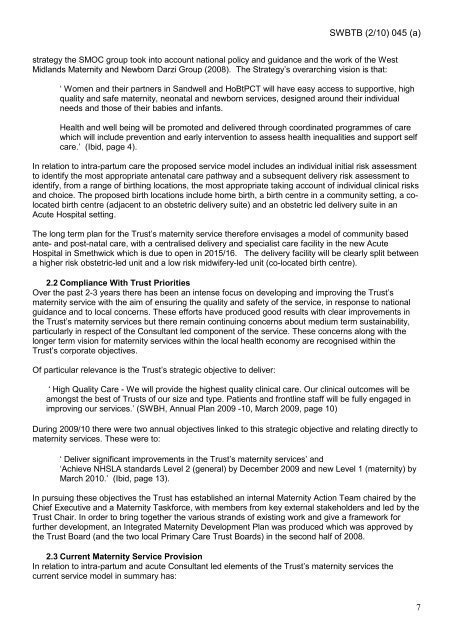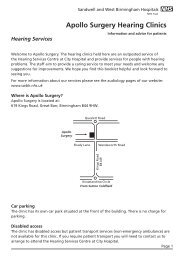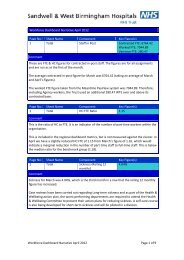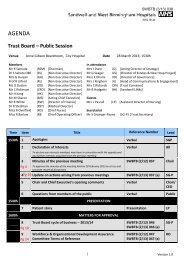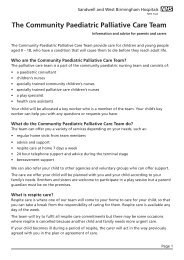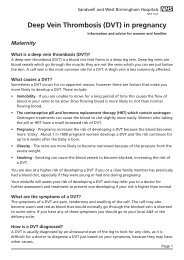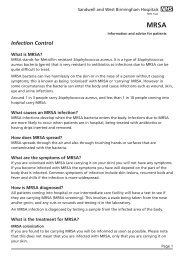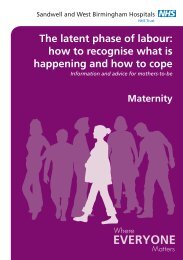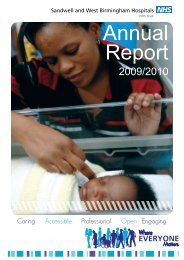Trust Board Febuary 2010 - Sandwell & West Birmingham Hospitals
Trust Board Febuary 2010 - Sandwell & West Birmingham Hospitals
Trust Board Febuary 2010 - Sandwell & West Birmingham Hospitals
You also want an ePaper? Increase the reach of your titles
YUMPU automatically turns print PDFs into web optimized ePapers that Google loves.
SWBTB (2/10) 045 (a)<br />
strategy the SMOC group took into account national policy and guidance and the work of the <strong>West</strong><br />
Midlands Maternity and Newborn Darzi Group (2008). The Strategy’s overarching vision is that:<br />
‘ Women and their partners in <strong>Sandwell</strong> and HoBtPCT will have easy access to supportive, high<br />
quality and safe maternity, neonatal and newborn services, designed around their individual<br />
needs and those of their babies and infants.<br />
Health and well being will be promoted and delivered through coordinated programmes of care<br />
which will include prevention and early intervention to assess health inequalities and support self<br />
care.’ (Ibid, page 4).<br />
In relation to intra-partum care the proposed service model includes an individual initial risk assessment<br />
to identify the most appropriate antenatal care pathway and a subsequent delivery risk assessment to<br />
identify, from a range of birthing locations, the most appropriate taking account of individual clinical risks<br />
and choice. The proposed birth locations include home birth, a birth centre in a community setting, a colocated<br />
birth centre (adjacent to an obstetric delivery suite) and an obstetric led delivery suite in an<br />
Acute Hospital setting.<br />
The long term plan for the <strong>Trust</strong>’s maternity service therefore envisages a model of community based<br />
ante- and post-natal care, with a centralised delivery and specialist care facility in the new Acute<br />
Hospital in Smethwick which is due to open in 2015/16. The delivery facility will be clearly split between<br />
a higher risk obstetric-led unit and a low risk midwifery-led unit (co-located birth centre).<br />
2.2 Compliance With <strong>Trust</strong> Priorities<br />
Over the past 2-3 years there has been an intense focus on developing and improving the <strong>Trust</strong>’s<br />
maternity service with the aim of ensuring the quality and safety of the service, in response to national<br />
guidance and to local concerns. These efforts have produced good results with clear improvements in<br />
the <strong>Trust</strong>’s maternity services but there remain continuing concerns about medium term sustainability,<br />
particularly in respect of the Consultant led component of the service. These concerns along with the<br />
longer term vision for maternity services within the local health economy are recognised within the<br />
<strong>Trust</strong>’s corporate objectives.<br />
Of particular relevance is the <strong>Trust</strong>’s strategic objective to deliver:<br />
‘ High Quality Care - We will provide the highest quality clinical care. Our clinical outcomes will be<br />
amongst the best of <strong>Trust</strong>s of our size and type. Patients and frontline staff will be fully engaged in<br />
improving our services.’ (SWBH, Annual Plan 2009 -10, March 2009, page 10)<br />
During 2009/10 there were two annual objectives linked to this strategic objective and relating directly to<br />
maternity services. These were to:<br />
‘ Deliver significant improvements in the <strong>Trust</strong>’s maternity services’ and<br />
‘Achieve NHSLA standards Level 2 (general) by December 2009 and new Level 1 (maternity) by<br />
March <strong>2010</strong>.’ (Ibid, page 13).<br />
In pursuing these objectives the <strong>Trust</strong> has established an internal Maternity Action Team chaired by the<br />
Chief Executive and a Maternity Taskforce, with members from key external stakeholders and led by the<br />
<strong>Trust</strong> Chair. In order to bring together the various strands of existing work and give a framework for<br />
further development, an Integrated Maternity Development Plan was produced which was approved by<br />
the <strong>Trust</strong> <strong>Board</strong> (and the two local Primary Care <strong>Trust</strong> <strong>Board</strong>s) in the second half of 2008.<br />
2.3 Current Maternity Service Provision<br />
In relation to intra-partum and acute Consultant led elements of the <strong>Trust</strong>’s maternity services the<br />
current service model in summary has:<br />
7


